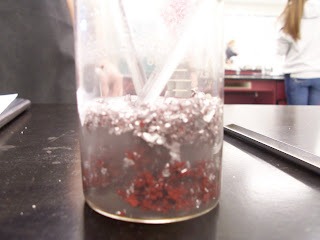THE PENNIUM LAB
INTRO: What is the average atomic mass of different pennium isotopes. Use the mass of a nickel to determine relative mass of all pennium isotopes. Investigate the concept of atomic mass and how it was derived. You will develop you own unit of measure, the CMU, and use it to measure the relative masses of other coins. At the conclusion of this lab you will be able to explain how scientists developed the system for AMU's ( atomic mass units) and how it is applied to determine the relative masses of other atoms of other elements.
OBSERVATIONS: We used pre 1982 pennies and post 1982 pennies, one dime, one nickel, and one quarter.
HYPOTHESIS: Weigh all coins and conclude the average amount of the individual sets of coins. Ex) post 1982 pennies, pre 1982 pennies, dime, nickel, and quarter. We separated all the coins out into there catagories. Then we weighed these coins on a triple beam balance scale. We believe that the older pennies will weigh more, because they are made out of different metals.
Materials: 1) 8 pre 1982 pennies.
2) 8 post 1982 pennies.
3) 1 dime.
4) 1 nickel.
5) 1 quarter.
6) Triple beam balance scale.
PROCEDURES: PART 1
1) Obtain a packet of pennies.
2) Sort the pennies into two groups: pre 1982 and 1982 and newer.
3) Measure the mass (in grams) of each stack of pennies. Record the mass (in grams) of each penny stack in a data table. Count the number of pennies in each stack.
4) Measure the mass in grams of a quarter, nickel, and dime. Record these values in a data table.
5) Answer the questions below and then continue with Part 2.
PROCEDURES: PART 2
- Determine the average mass of pre-1982 pennies. (Record average)
- Determine the average mass of post-1982 pennies. (Record average)
- Determine the percentage of your pennies that is Pre-1982 and the percentage that is post 1982. These percents should add up to 100%. What you have calculated is the percent abundance of each group of pennies (penny isotope)
- Let's choose one of your coins to make a CMU (coin mass unit). Let's say that the mass of a nickel ( Fivecentium). is one CMU. Use the mass of a nickel to calculate the mass of a quarter (Quarterium), dime (Dimeium), pre-82 pennies (Pre-82 Pennium), post-82 pennies (Post-82 Pennium. Again, show all calculations, and record all data in a data table.
- Determine the average mass of Pennium in CMU's using the percent abundance (from # 3) of each pennium isotope (pre-82 and post 82) and the mass of each pennium isotope in CMU's (from # 4).
Discussion: In summary, the Pre 1982 pennies weighed more which may be result to using metals to make the coins. IN the lab we weighted various kinds of coiniums on a triple beam balance scale.
Isotopes - are atoms of the same element that have the same atomic number but different masses.
MASS: measure of the amount of matter that abject contains.
MATTER: anything that has mass and ocupies space.
ATOMIC NUMBER: number of protons in the nucleus.
MASS NUMBER: is equal to protons plus electrons.
CONCLUSION: We accept our hypothesis. We said that the post coins would turn out to weigh more. And when we tested. This is what the outcome was. They weighed almost a hole 3 more grams than the "pre" pennies did. Then when we weighed all the other coins it really wasn't that big of a shock for what they would come out to be. We new of course the quarter would weigh more, and that the dime would be the smallest in mass.
Isotopes - are atoms of the same element that have the same atomic number but different masses.
MASS: measure of the amount of matter that abject contains.
MATTER: anything that has mass and ocupies space.
ATOMIC NUMBER: number of protons in the nucleus.
MASS NUMBER: is equal to protons plus electrons.
CONCLUSION: We accept our hypothesis. We said that the post coins would turn out to weigh more. And when we tested. This is what the outcome was. They weighed almost a hole 3 more grams than the "pre" pennies did. Then when we weighed all the other coins it really wasn't that big of a shock for what they would come out to be. We new of course the quarter would weigh more, and that the dime would be the smallest in mass.
















